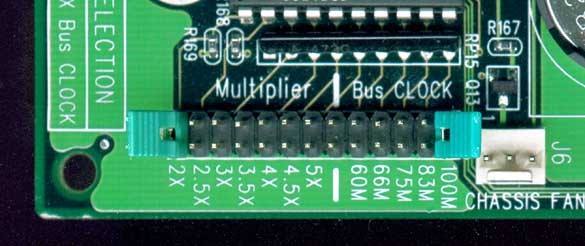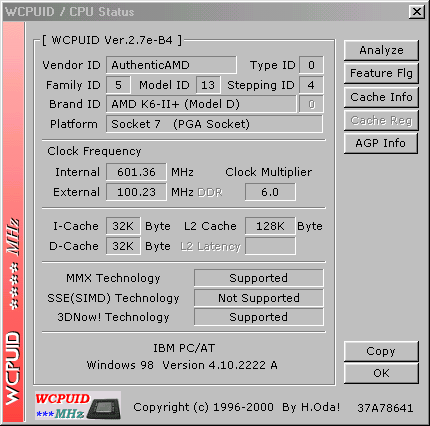600 MHz with Socket 7: The AMD K6-2+
Which PCs Or Boards Are Suited For The Upgrade?
The correct core voltage is crucial: The AMD K6-2+ is specified for 2.0 Volts. In our test it ran completely stable at 2.1 Volts. Higher voltages should be avoided, however.
In principle the AMD K6-2+ fits in every motherboard with a Socket 7 interface. However, in practice there are a few requirements: The motherboard must support a core voltage of 2.0 Volts or a maximum of 2.1 Volts. Quite often this is not the case with very old boards from 1996 and 1997 that are based on Intel's 430HX, 430VX, or 430TX chipset, because the voltage controller on these boards offers a minimum voltage of 2.2 Volts. One of the exceptions is the legendary Asus P55T2P4 (starting with revision 3.x) that supports the required voltage for the K6-2+. Motherboards with VIA VP3, VIA MVP3, Ali Aladdin V or SiS530/5598 chipset that are up to three years old are less problematic, because in most cases the voltage controller supports at least 2.1 Volts.
5.5 is the limit: The largest possible multiplier is 5.5 for all Socket 7 boards. However: The AMD K6-2+ interprets the setting "2" as multiplier 6
Another important prerequisite is the clock frequency multiplier. The K6-2+/550 requires a multiplier of 5.5, which is actually offered by most boards. In the case of the Asus P55T2P4 there are no references for setting the jumpers for multipliers larger than 3.5, neither on the board itself nor in the handbook. Trying all the different jumper combinations is often the only way to find out the appropriate settings. Because most of the older boards officially only allow a system clock of 66 MHz, the clock frequency must be operated outside the specification. For example both the Asus P55T2P4 and the Abit IT5H (both boards with Intel 430HX chipset) support a system clock of 75 or 83 MHz. Otherwise the maximum possible core frequency of the K6-2+ is limited to 66 x 6 = 400 MHz. Even though no Socket 7 board supports a multiplier of "6", it may still be achieved by setting the multiplier to "2". The AMD K6-2+ interprets this as the value 6. Users who own a board with VIA MVP3, Ali Aladdin V or SiS530/5598 chipset are on the safe side. These components offer a system clock of 100 MHz, allowing you to use the K6-2+ without having to overclock the system bus.
Overclocking: 600 MHz With Socket 7!
This has never happened before: 600 MHz based on Socket 7. Now an old system upgraded with a K6-2+ can achieve the performance level of current PCs.
Our test sample was an AMD K6-2+/500 that ran on an Aopen AX59 Pro without any problems. Because the board does not offer support for 2.0 Volt, we used the 2.1 Volt setting. The marginally higher voltage did not have an influence on the system stability. During the test we discovered surprising results from overclocking: For the setting 5.5 x 100 = 550 MHz as well as for 6 x 100 = 600 MHz we observed no instabilities! This result is a phenomenal considering that the AMD K6 and AMD K6-2 processors have been totally unsuitable for overclocking in the past. The 0.18 µm process technology that generally allows higher clock frequencies is certainly one reason for this behavior. The multiplier and the supported system clock are the only limiting factors for pushing the clock frequency even higher. Overclocking the K6-2+ processor on a suitable motherboard with VIA MVP3, Ali Aladdin V or SiS530/5598 chipset that supports a system clock frequency above 100 MHz could certainly provide an even higher performance gain.
Get Tom's Hardware's best news and in-depth reviews, straight to your inbox.
Current page: Which PCs Or Boards Are Suited For The Upgrade?
Prev Page AMD K6-2+ In Detail, Continued Next Page Test Setup

